Swinburne INF30003: Business Information System Analysis of Bookbarn
VerifiedAdded on 2023/01/19
|10
|2271
|40
Report
AI Summary
This report provides a comprehensive business analysis of the Bookbarn case study, focusing on the identification and evaluation of key business problems within the organization. The analysis begins by identifying the primary issues, including the manual ordering system, employment challenges, increased competition, and internal disagreements. The manual ordering system is highlighted as the most problematic, due to its impact on efficiency and customer satisfaction. The report categorizes problems as either hard or soft system problems, with examples provided. Key stakeholders, including employees, Bob, and Clare, are identified, with Bob being the problem owner due to his resistance to change. Various models, tools, and techniques are suggested for analyzing the current system, such as Gantt charts and logic networks. Finally, a rich picture is presented to visually represent the complex relationships and issues within Bookbarn, offering a holistic view of the organization's challenges and potential areas for improvement. The assignment demonstrates a solid understanding of business analysis principles and their application to a real-world scenario.
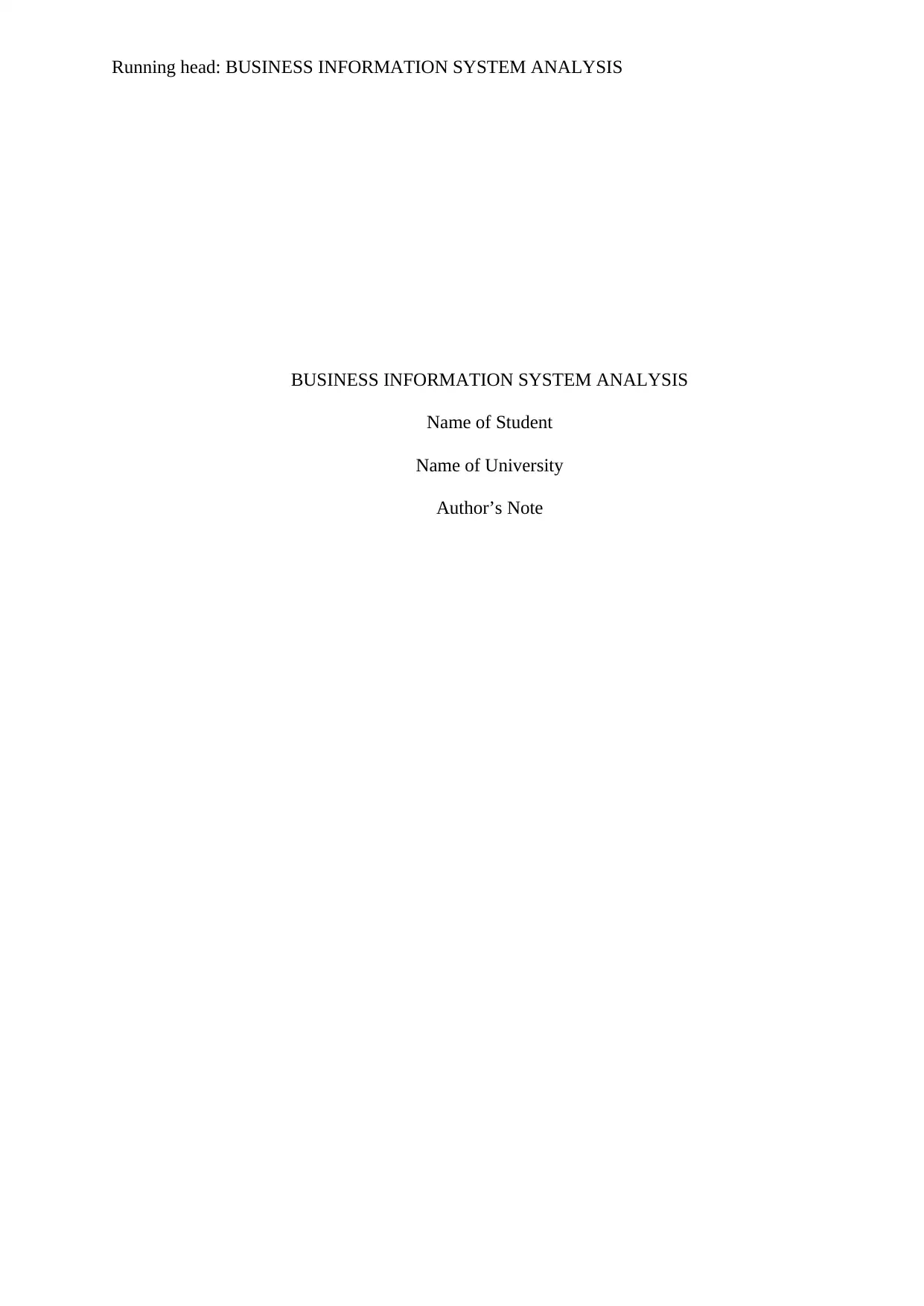
Running head: BUSINESS INFORMATION SYSTEM ANALYSIS
BUSINESS INFORMATION SYSTEM ANALYSIS
Name of Student
Name of University
Author’s Note
BUSINESS INFORMATION SYSTEM ANALYSIS
Name of Student
Name of University
Author’s Note
Paraphrase This Document
Need a fresh take? Get an instant paraphrase of this document with our AI Paraphraser
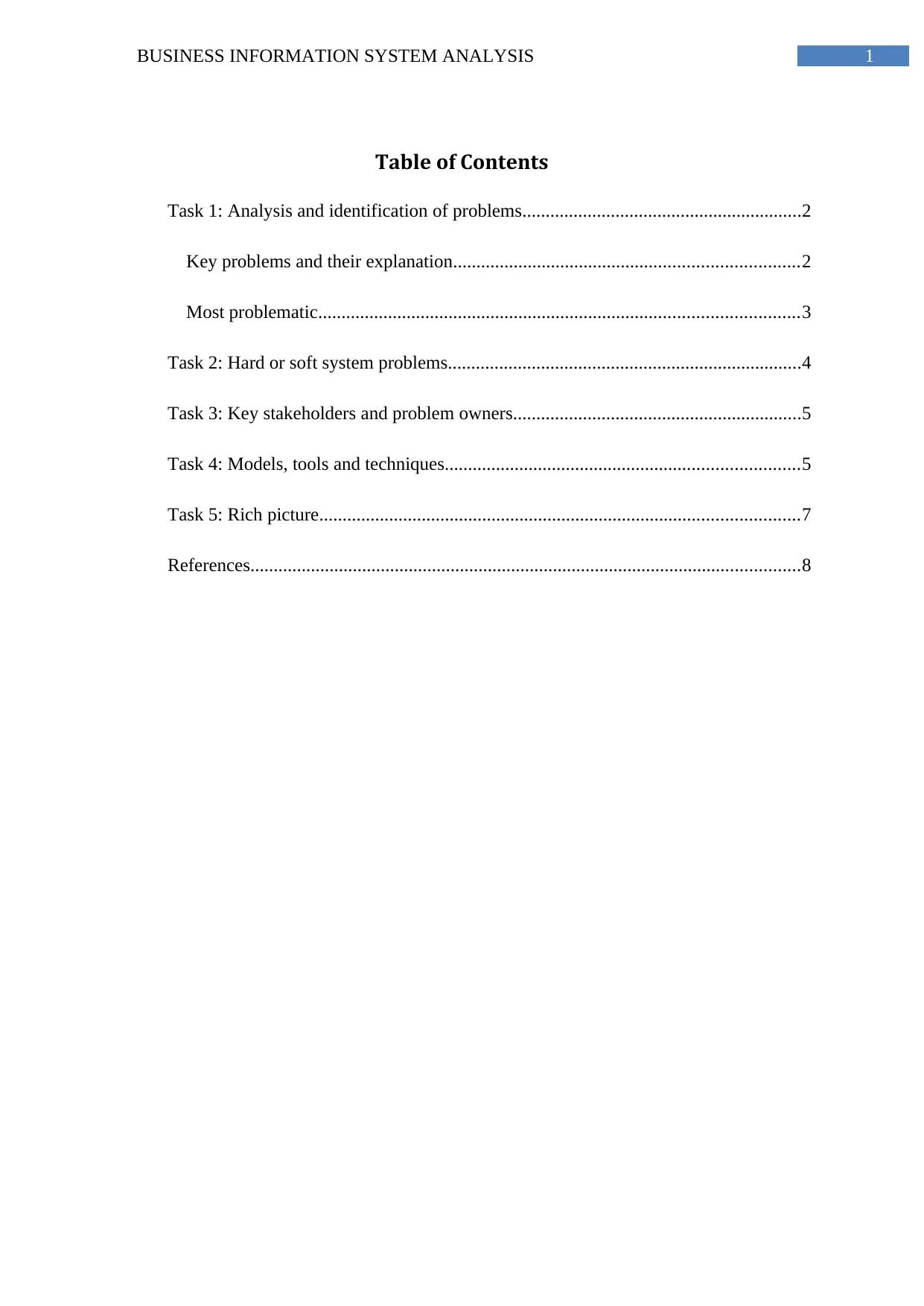
1BUSINESS INFORMATION SYSTEM ANALYSIS
Table of Contents
Task 1: Analysis and identification of problems............................................................2
Key problems and their explanation..........................................................................2
Most problematic.......................................................................................................3
Task 2: Hard or soft system problems............................................................................4
Task 3: Key stakeholders and problem owners..............................................................5
Task 4: Models, tools and techniques............................................................................5
Task 5: Rich picture.......................................................................................................7
References......................................................................................................................8
Table of Contents
Task 1: Analysis and identification of problems............................................................2
Key problems and their explanation..........................................................................2
Most problematic.......................................................................................................3
Task 2: Hard or soft system problems............................................................................4
Task 3: Key stakeholders and problem owners..............................................................5
Task 4: Models, tools and techniques............................................................................5
Task 5: Rich picture.......................................................................................................7
References......................................................................................................................8
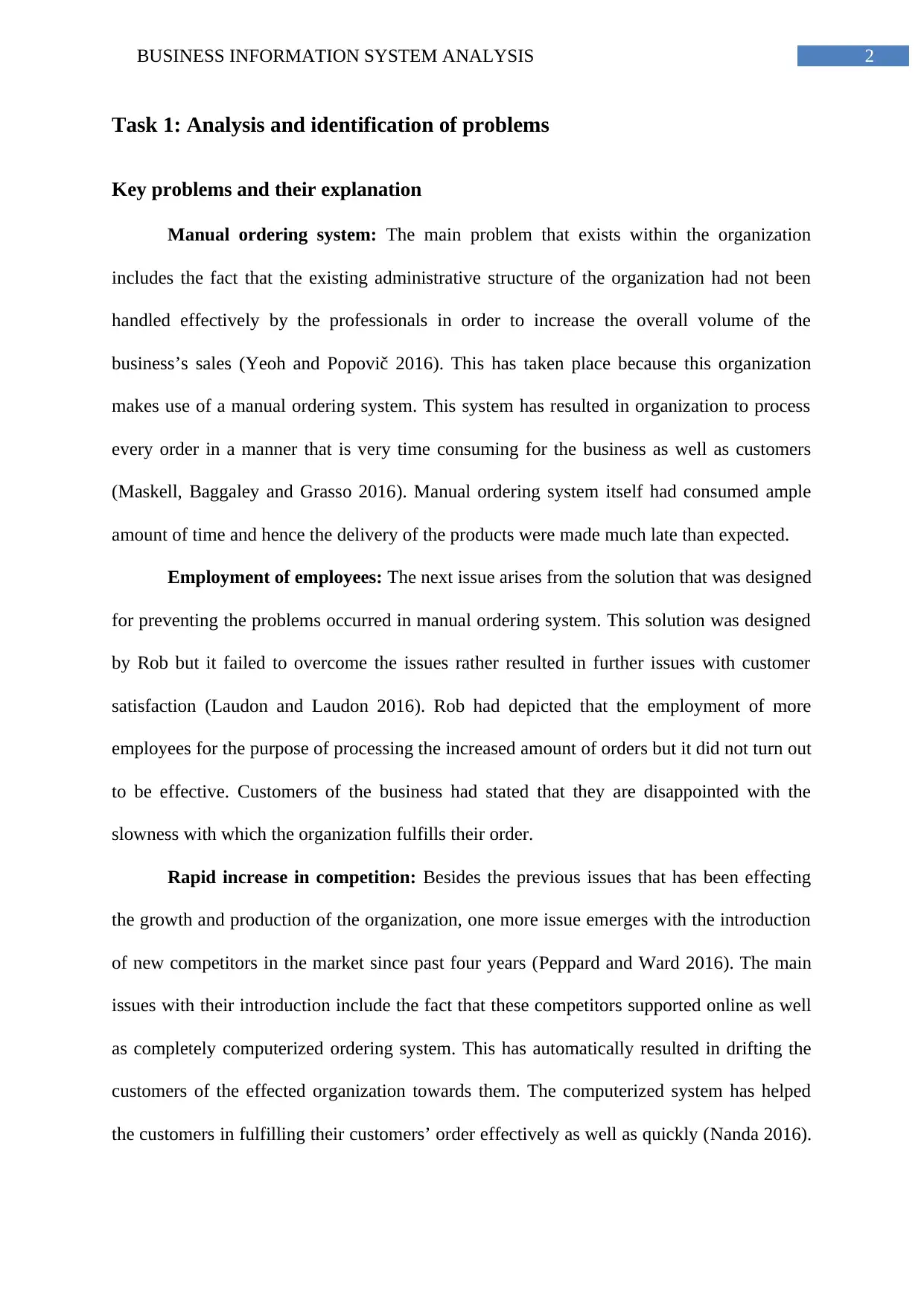
2BUSINESS INFORMATION SYSTEM ANALYSIS
Task 1: Analysis and identification of problems
Key problems and their explanation
Manual ordering system: The main problem that exists within the organization
includes the fact that the existing administrative structure of the organization had not been
handled effectively by the professionals in order to increase the overall volume of the
business’s sales (Yeoh and Popovič 2016). This has taken place because this organization
makes use of a manual ordering system. This system has resulted in organization to process
every order in a manner that is very time consuming for the business as well as customers
(Maskell, Baggaley and Grasso 2016). Manual ordering system itself had consumed ample
amount of time and hence the delivery of the products were made much late than expected.
Employment of employees: The next issue arises from the solution that was designed
for preventing the problems occurred in manual ordering system. This solution was designed
by Rob but it failed to overcome the issues rather resulted in further issues with customer
satisfaction (Laudon and Laudon 2016). Rob had depicted that the employment of more
employees for the purpose of processing the increased amount of orders but it did not turn out
to be effective. Customers of the business had stated that they are disappointed with the
slowness with which the organization fulfills their order.
Rapid increase in competition: Besides the previous issues that has been effecting
the growth and production of the organization, one more issue emerges with the introduction
of new competitors in the market since past four years (Peppard and Ward 2016). The main
issues with their introduction include the fact that these competitors supported online as well
as completely computerized ordering system. This has automatically resulted in drifting the
customers of the effected organization towards them. The computerized system has helped
the customers in fulfilling their customers’ order effectively as well as quickly (Nanda 2016).
Task 1: Analysis and identification of problems
Key problems and their explanation
Manual ordering system: The main problem that exists within the organization
includes the fact that the existing administrative structure of the organization had not been
handled effectively by the professionals in order to increase the overall volume of the
business’s sales (Yeoh and Popovič 2016). This has taken place because this organization
makes use of a manual ordering system. This system has resulted in organization to process
every order in a manner that is very time consuming for the business as well as customers
(Maskell, Baggaley and Grasso 2016). Manual ordering system itself had consumed ample
amount of time and hence the delivery of the products were made much late than expected.
Employment of employees: The next issue arises from the solution that was designed
for preventing the problems occurred in manual ordering system. This solution was designed
by Rob but it failed to overcome the issues rather resulted in further issues with customer
satisfaction (Laudon and Laudon 2016). Rob had depicted that the employment of more
employees for the purpose of processing the increased amount of orders but it did not turn out
to be effective. Customers of the business had stated that they are disappointed with the
slowness with which the organization fulfills their order.
Rapid increase in competition: Besides the previous issues that has been effecting
the growth and production of the organization, one more issue emerges with the introduction
of new competitors in the market since past four years (Peppard and Ward 2016). The main
issues with their introduction include the fact that these competitors supported online as well
as completely computerized ordering system. This has automatically resulted in drifting the
customers of the effected organization towards them. The computerized system has helped
the customers in fulfilling their customers’ order effectively as well as quickly (Nanda 2016).
⊘ This is a preview!⊘
Do you want full access?
Subscribe today to unlock all pages.

Trusted by 1+ million students worldwide
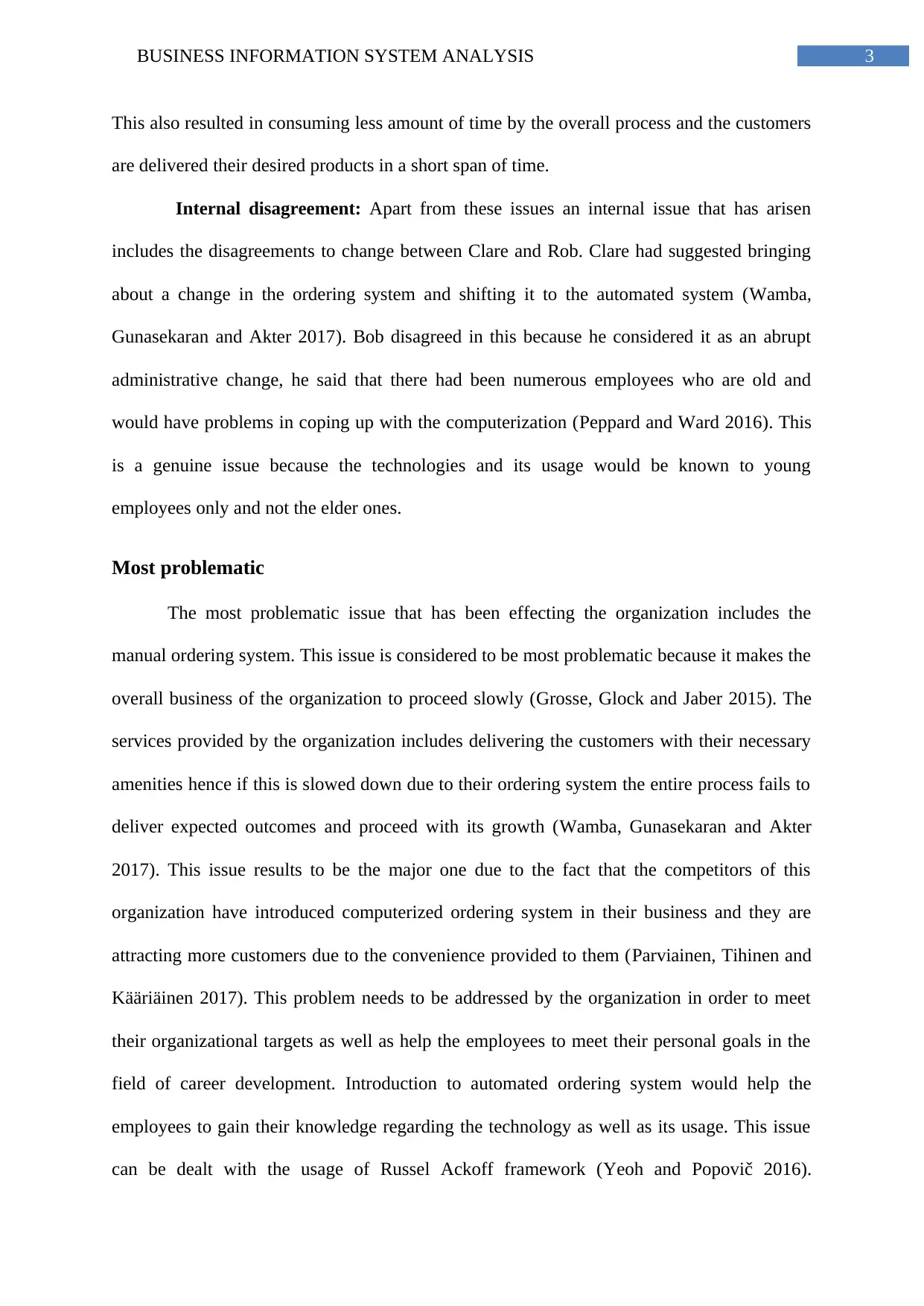
3BUSINESS INFORMATION SYSTEM ANALYSIS
This also resulted in consuming less amount of time by the overall process and the customers
are delivered their desired products in a short span of time.
Internal disagreement: Apart from these issues an internal issue that has arisen
includes the disagreements to change between Clare and Rob. Clare had suggested bringing
about a change in the ordering system and shifting it to the automated system (Wamba,
Gunasekaran and Akter 2017). Bob disagreed in this because he considered it as an abrupt
administrative change, he said that there had been numerous employees who are old and
would have problems in coping up with the computerization (Peppard and Ward 2016). This
is a genuine issue because the technologies and its usage would be known to young
employees only and not the elder ones.
Most problematic
The most problematic issue that has been effecting the organization includes the
manual ordering system. This issue is considered to be most problematic because it makes the
overall business of the organization to proceed slowly (Grosse, Glock and Jaber 2015). The
services provided by the organization includes delivering the customers with their necessary
amenities hence if this is slowed down due to their ordering system the entire process fails to
deliver expected outcomes and proceed with its growth (Wamba, Gunasekaran and Akter
2017). This issue results to be the major one due to the fact that the competitors of this
organization have introduced computerized ordering system in their business and they are
attracting more customers due to the convenience provided to them (Parviainen, Tihinen and
Kääriäinen 2017). This problem needs to be addressed by the organization in order to meet
their organizational targets as well as help the employees to meet their personal goals in the
field of career development. Introduction to automated ordering system would help the
employees to gain their knowledge regarding the technology as well as its usage. This issue
can be dealt with the usage of Russel Ackoff framework (Yeoh and Popovič 2016).
This also resulted in consuming less amount of time by the overall process and the customers
are delivered their desired products in a short span of time.
Internal disagreement: Apart from these issues an internal issue that has arisen
includes the disagreements to change between Clare and Rob. Clare had suggested bringing
about a change in the ordering system and shifting it to the automated system (Wamba,
Gunasekaran and Akter 2017). Bob disagreed in this because he considered it as an abrupt
administrative change, he said that there had been numerous employees who are old and
would have problems in coping up with the computerization (Peppard and Ward 2016). This
is a genuine issue because the technologies and its usage would be known to young
employees only and not the elder ones.
Most problematic
The most problematic issue that has been effecting the organization includes the
manual ordering system. This issue is considered to be most problematic because it makes the
overall business of the organization to proceed slowly (Grosse, Glock and Jaber 2015). The
services provided by the organization includes delivering the customers with their necessary
amenities hence if this is slowed down due to their ordering system the entire process fails to
deliver expected outcomes and proceed with its growth (Wamba, Gunasekaran and Akter
2017). This issue results to be the major one due to the fact that the competitors of this
organization have introduced computerized ordering system in their business and they are
attracting more customers due to the convenience provided to them (Parviainen, Tihinen and
Kääriäinen 2017). This problem needs to be addressed by the organization in order to meet
their organizational targets as well as help the employees to meet their personal goals in the
field of career development. Introduction to automated ordering system would help the
employees to gain their knowledge regarding the technology as well as its usage. This issue
can be dealt with the usage of Russel Ackoff framework (Yeoh and Popovič 2016).
Paraphrase This Document
Need a fresh take? Get an instant paraphrase of this document with our AI Paraphraser
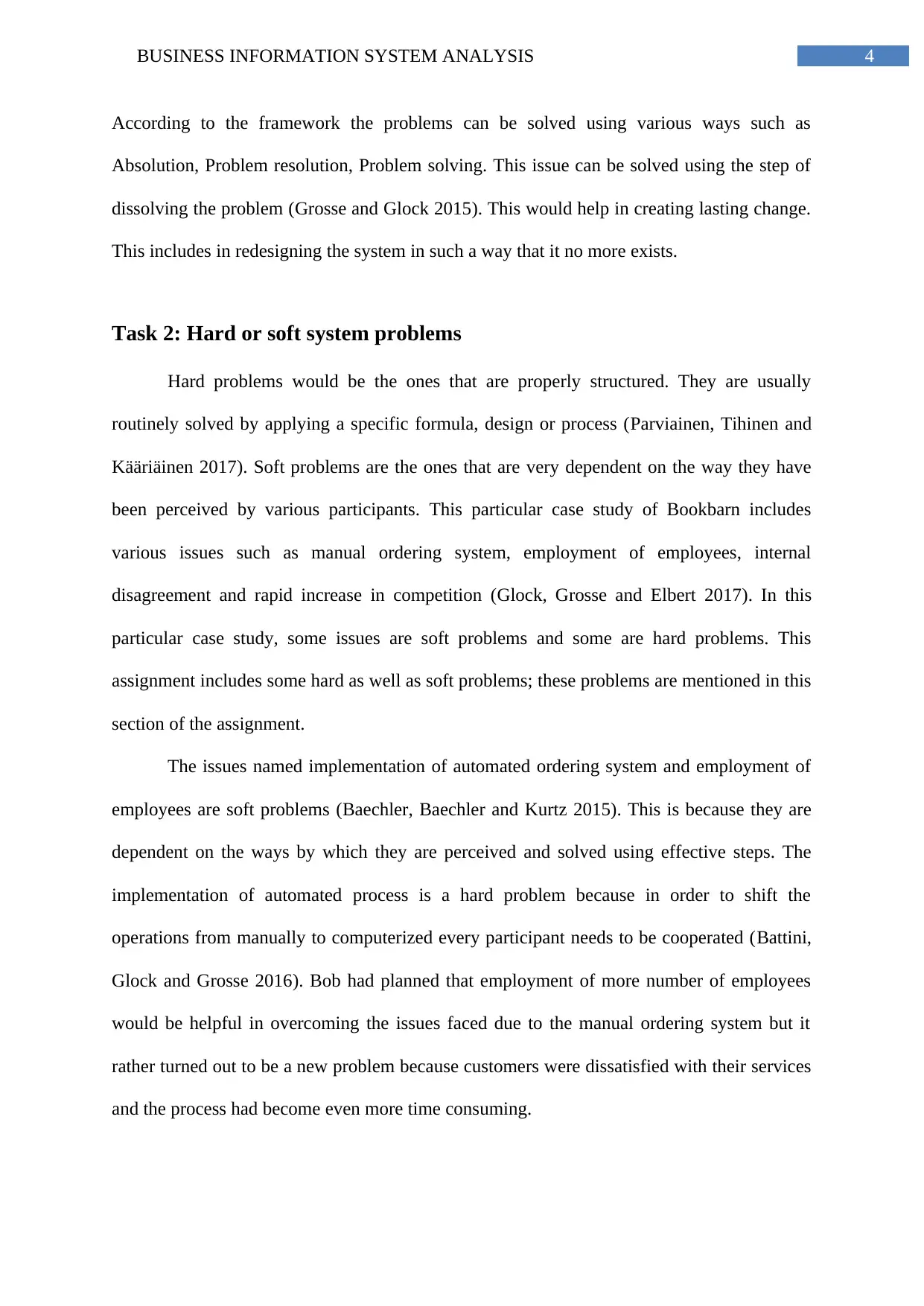
4BUSINESS INFORMATION SYSTEM ANALYSIS
According to the framework the problems can be solved using various ways such as
Absolution, Problem resolution, Problem solving. This issue can be solved using the step of
dissolving the problem (Grosse and Glock 2015). This would help in creating lasting change.
This includes in redesigning the system in such a way that it no more exists.
Task 2: Hard or soft system problems
Hard problems would be the ones that are properly structured. They are usually
routinely solved by applying a specific formula, design or process (Parviainen, Tihinen and
Kääriäinen 2017). Soft problems are the ones that are very dependent on the way they have
been perceived by various participants. This particular case study of Bookbarn includes
various issues such as manual ordering system, employment of employees, internal
disagreement and rapid increase in competition (Glock, Grosse and Elbert 2017). In this
particular case study, some issues are soft problems and some are hard problems. This
assignment includes some hard as well as soft problems; these problems are mentioned in this
section of the assignment.
The issues named implementation of automated ordering system and employment of
employees are soft problems (Baechler, Baechler and Kurtz 2015). This is because they are
dependent on the ways by which they are perceived and solved using effective steps. The
implementation of automated process is a hard problem because in order to shift the
operations from manually to computerized every participant needs to be cooperated (Battini,
Glock and Grosse 2016). Bob had planned that employment of more number of employees
would be helpful in overcoming the issues faced due to the manual ordering system but it
rather turned out to be a new problem because customers were dissatisfied with their services
and the process had become even more time consuming.
According to the framework the problems can be solved using various ways such as
Absolution, Problem resolution, Problem solving. This issue can be solved using the step of
dissolving the problem (Grosse and Glock 2015). This would help in creating lasting change.
This includes in redesigning the system in such a way that it no more exists.
Task 2: Hard or soft system problems
Hard problems would be the ones that are properly structured. They are usually
routinely solved by applying a specific formula, design or process (Parviainen, Tihinen and
Kääriäinen 2017). Soft problems are the ones that are very dependent on the way they have
been perceived by various participants. This particular case study of Bookbarn includes
various issues such as manual ordering system, employment of employees, internal
disagreement and rapid increase in competition (Glock, Grosse and Elbert 2017). In this
particular case study, some issues are soft problems and some are hard problems. This
assignment includes some hard as well as soft problems; these problems are mentioned in this
section of the assignment.
The issues named implementation of automated ordering system and employment of
employees are soft problems (Baechler, Baechler and Kurtz 2015). This is because they are
dependent on the ways by which they are perceived and solved using effective steps. The
implementation of automated process is a hard problem because in order to shift the
operations from manually to computerized every participant needs to be cooperated (Battini,
Glock and Grosse 2016). Bob had planned that employment of more number of employees
would be helpful in overcoming the issues faced due to the manual ordering system but it
rather turned out to be a new problem because customers were dissatisfied with their services
and the process had become even more time consuming.
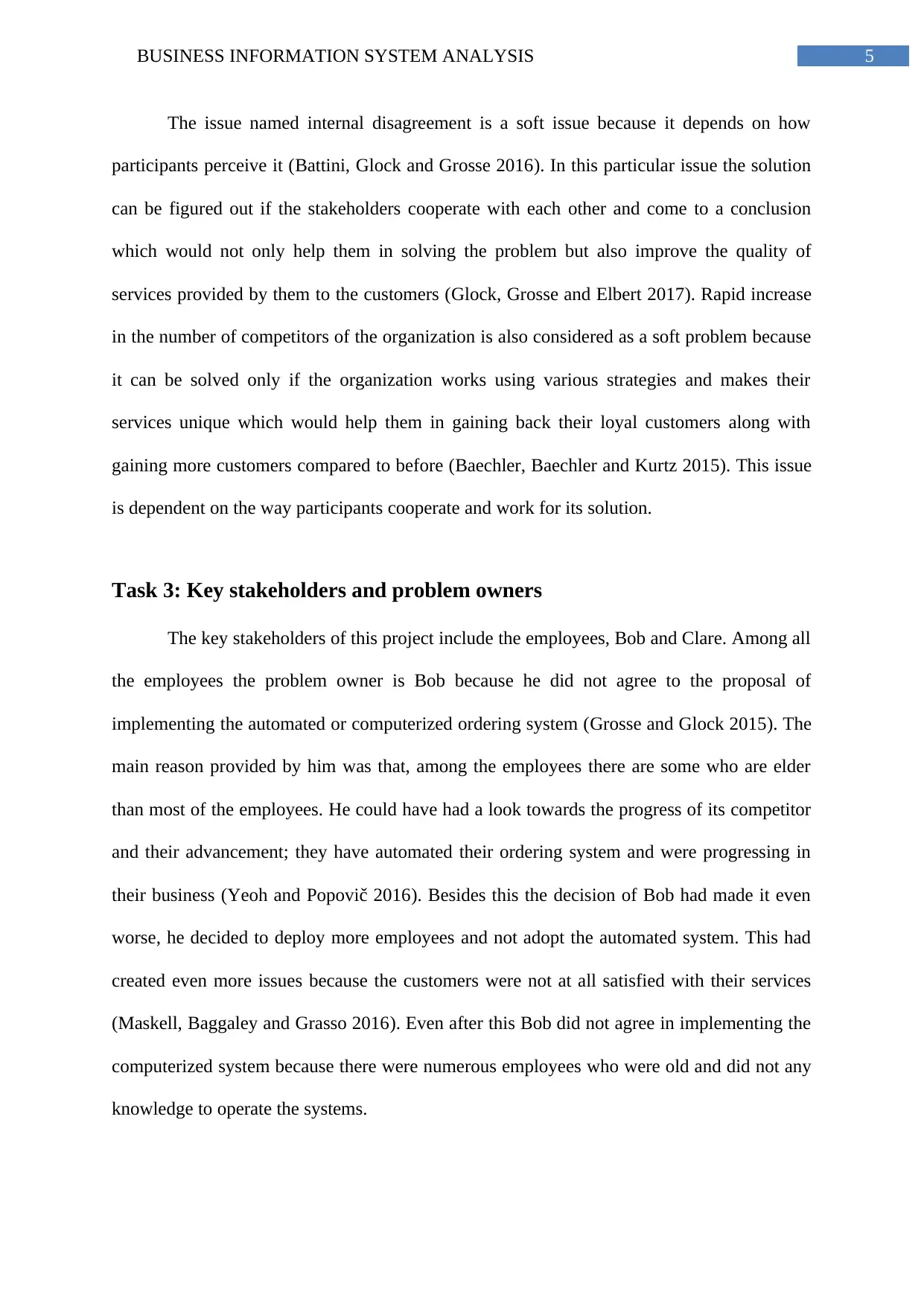
5BUSINESS INFORMATION SYSTEM ANALYSIS
The issue named internal disagreement is a soft issue because it depends on how
participants perceive it (Battini, Glock and Grosse 2016). In this particular issue the solution
can be figured out if the stakeholders cooperate with each other and come to a conclusion
which would not only help them in solving the problem but also improve the quality of
services provided by them to the customers (Glock, Grosse and Elbert 2017). Rapid increase
in the number of competitors of the organization is also considered as a soft problem because
it can be solved only if the organization works using various strategies and makes their
services unique which would help them in gaining back their loyal customers along with
gaining more customers compared to before (Baechler, Baechler and Kurtz 2015). This issue
is dependent on the way participants cooperate and work for its solution.
Task 3: Key stakeholders and problem owners
The key stakeholders of this project include the employees, Bob and Clare. Among all
the employees the problem owner is Bob because he did not agree to the proposal of
implementing the automated or computerized ordering system (Grosse and Glock 2015). The
main reason provided by him was that, among the employees there are some who are elder
than most of the employees. He could have had a look towards the progress of its competitor
and their advancement; they have automated their ordering system and were progressing in
their business (Yeoh and Popovič 2016). Besides this the decision of Bob had made it even
worse, he decided to deploy more employees and not adopt the automated system. This had
created even more issues because the customers were not at all satisfied with their services
(Maskell, Baggaley and Grasso 2016). Even after this Bob did not agree in implementing the
computerized system because there were numerous employees who were old and did not any
knowledge to operate the systems.
The issue named internal disagreement is a soft issue because it depends on how
participants perceive it (Battini, Glock and Grosse 2016). In this particular issue the solution
can be figured out if the stakeholders cooperate with each other and come to a conclusion
which would not only help them in solving the problem but also improve the quality of
services provided by them to the customers (Glock, Grosse and Elbert 2017). Rapid increase
in the number of competitors of the organization is also considered as a soft problem because
it can be solved only if the organization works using various strategies and makes their
services unique which would help them in gaining back their loyal customers along with
gaining more customers compared to before (Baechler, Baechler and Kurtz 2015). This issue
is dependent on the way participants cooperate and work for its solution.
Task 3: Key stakeholders and problem owners
The key stakeholders of this project include the employees, Bob and Clare. Among all
the employees the problem owner is Bob because he did not agree to the proposal of
implementing the automated or computerized ordering system (Grosse and Glock 2015). The
main reason provided by him was that, among the employees there are some who are elder
than most of the employees. He could have had a look towards the progress of its competitor
and their advancement; they have automated their ordering system and were progressing in
their business (Yeoh and Popovič 2016). Besides this the decision of Bob had made it even
worse, he decided to deploy more employees and not adopt the automated system. This had
created even more issues because the customers were not at all satisfied with their services
(Maskell, Baggaley and Grasso 2016). Even after this Bob did not agree in implementing the
computerized system because there were numerous employees who were old and did not any
knowledge to operate the systems.
⊘ This is a preview!⊘
Do you want full access?
Subscribe today to unlock all pages.

Trusted by 1+ million students worldwide
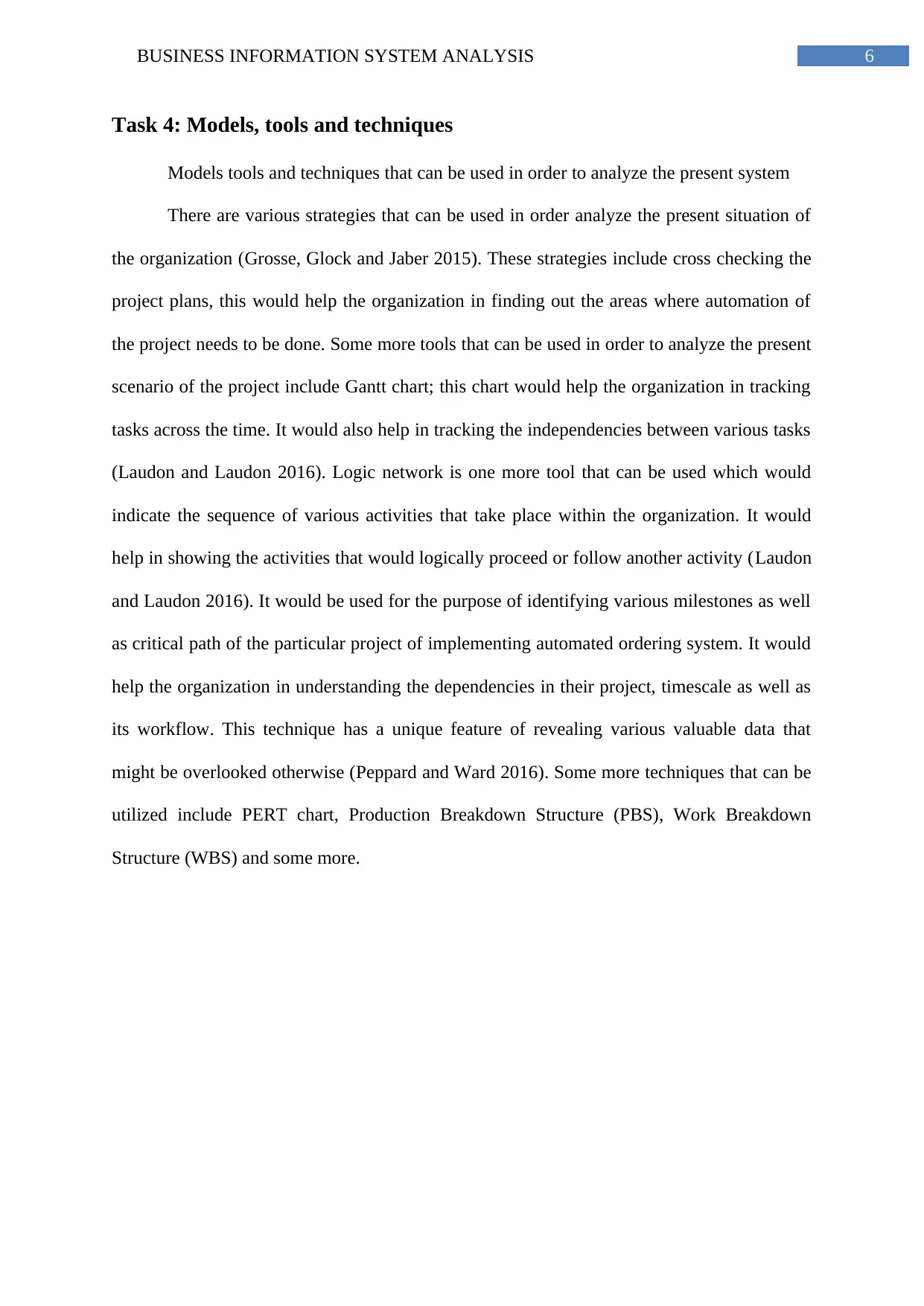
6BUSINESS INFORMATION SYSTEM ANALYSIS
Task 4: Models, tools and techniques
Models tools and techniques that can be used in order to analyze the present system
There are various strategies that can be used in order analyze the present situation of
the organization (Grosse, Glock and Jaber 2015). These strategies include cross checking the
project plans, this would help the organization in finding out the areas where automation of
the project needs to be done. Some more tools that can be used in order to analyze the present
scenario of the project include Gantt chart; this chart would help the organization in tracking
tasks across the time. It would also help in tracking the independencies between various tasks
(Laudon and Laudon 2016). Logic network is one more tool that can be used which would
indicate the sequence of various activities that take place within the organization. It would
help in showing the activities that would logically proceed or follow another activity (Laudon
and Laudon 2016). It would be used for the purpose of identifying various milestones as well
as critical path of the particular project of implementing automated ordering system. It would
help the organization in understanding the dependencies in their project, timescale as well as
its workflow. This technique has a unique feature of revealing various valuable data that
might be overlooked otherwise (Peppard and Ward 2016). Some more techniques that can be
utilized include PERT chart, Production Breakdown Structure (PBS), Work Breakdown
Structure (WBS) and some more.
Task 4: Models, tools and techniques
Models tools and techniques that can be used in order to analyze the present system
There are various strategies that can be used in order analyze the present situation of
the organization (Grosse, Glock and Jaber 2015). These strategies include cross checking the
project plans, this would help the organization in finding out the areas where automation of
the project needs to be done. Some more tools that can be used in order to analyze the present
scenario of the project include Gantt chart; this chart would help the organization in tracking
tasks across the time. It would also help in tracking the independencies between various tasks
(Laudon and Laudon 2016). Logic network is one more tool that can be used which would
indicate the sequence of various activities that take place within the organization. It would
help in showing the activities that would logically proceed or follow another activity (Laudon
and Laudon 2016). It would be used for the purpose of identifying various milestones as well
as critical path of the particular project of implementing automated ordering system. It would
help the organization in understanding the dependencies in their project, timescale as well as
its workflow. This technique has a unique feature of revealing various valuable data that
might be overlooked otherwise (Peppard and Ward 2016). Some more techniques that can be
utilized include PERT chart, Production Breakdown Structure (PBS), Work Breakdown
Structure (WBS) and some more.
Paraphrase This Document
Need a fresh take? Get an instant paraphrase of this document with our AI Paraphraser
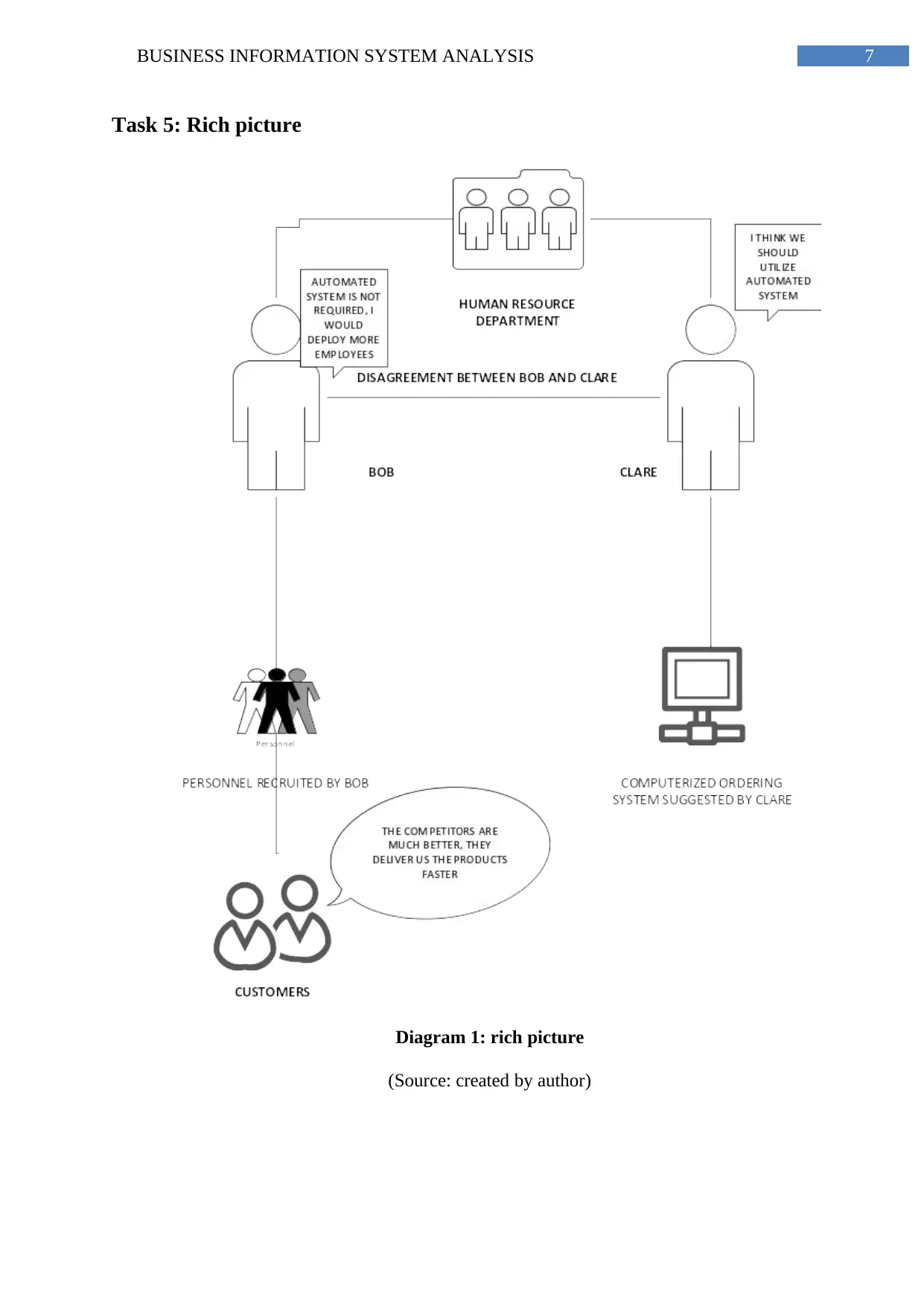
7BUSINESS INFORMATION SYSTEM ANALYSIS
Task 5: Rich picture
Diagram 1: rich picture
(Source: created by author)
Task 5: Rich picture
Diagram 1: rich picture
(Source: created by author)
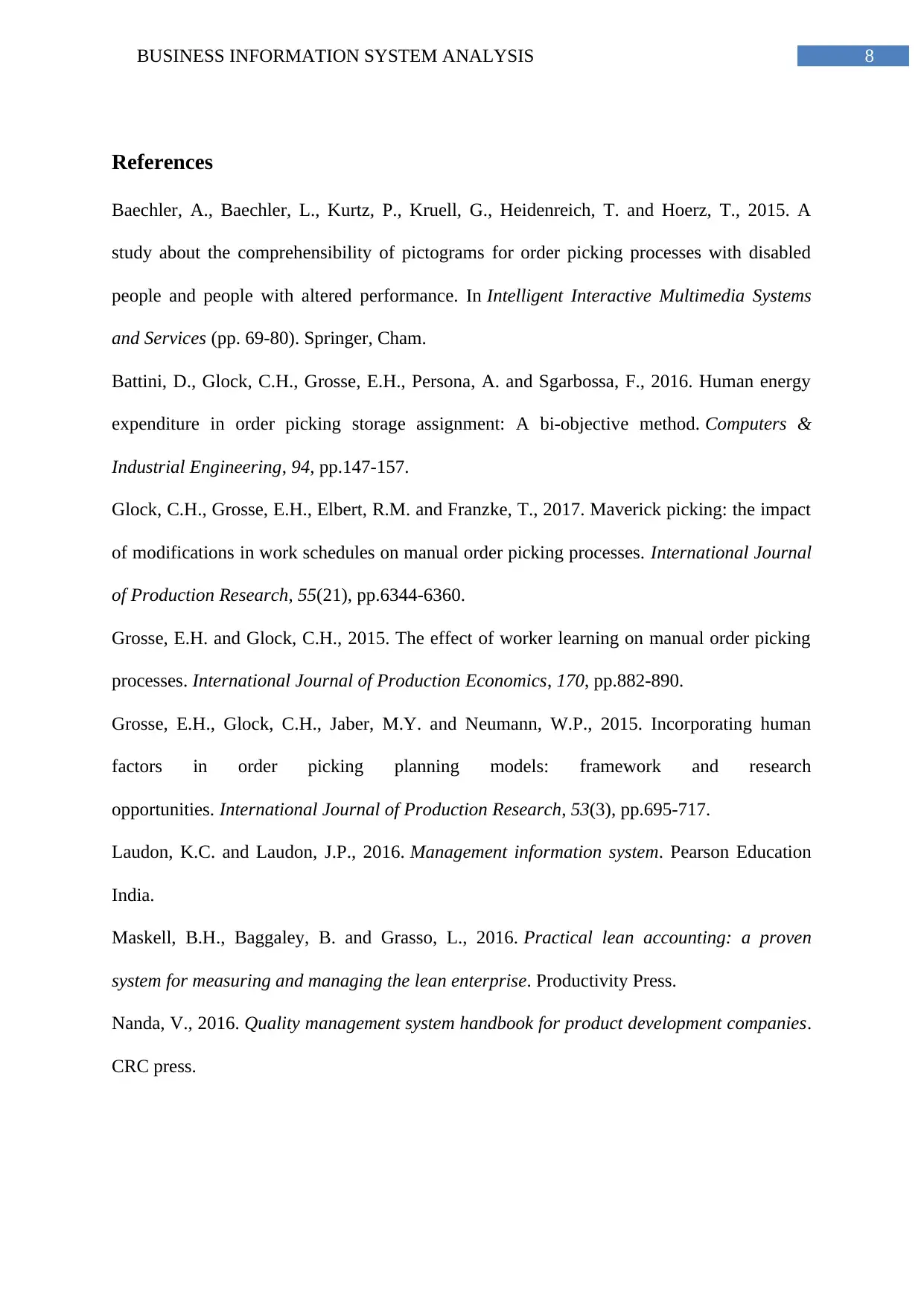
8BUSINESS INFORMATION SYSTEM ANALYSIS
References
Baechler, A., Baechler, L., Kurtz, P., Kruell, G., Heidenreich, T. and Hoerz, T., 2015. A
study about the comprehensibility of pictograms for order picking processes with disabled
people and people with altered performance. In Intelligent Interactive Multimedia Systems
and Services (pp. 69-80). Springer, Cham.
Battini, D., Glock, C.H., Grosse, E.H., Persona, A. and Sgarbossa, F., 2016. Human energy
expenditure in order picking storage assignment: A bi-objective method. Computers &
Industrial Engineering, 94, pp.147-157.
Glock, C.H., Grosse, E.H., Elbert, R.M. and Franzke, T., 2017. Maverick picking: the impact
of modifications in work schedules on manual order picking processes. International Journal
of Production Research, 55(21), pp.6344-6360.
Grosse, E.H. and Glock, C.H., 2015. The effect of worker learning on manual order picking
processes. International Journal of Production Economics, 170, pp.882-890.
Grosse, E.H., Glock, C.H., Jaber, M.Y. and Neumann, W.P., 2015. Incorporating human
factors in order picking planning models: framework and research
opportunities. International Journal of Production Research, 53(3), pp.695-717.
Laudon, K.C. and Laudon, J.P., 2016. Management information system. Pearson Education
India.
Maskell, B.H., Baggaley, B. and Grasso, L., 2016. Practical lean accounting: a proven
system for measuring and managing the lean enterprise. Productivity Press.
Nanda, V., 2016. Quality management system handbook for product development companies.
CRC press.
References
Baechler, A., Baechler, L., Kurtz, P., Kruell, G., Heidenreich, T. and Hoerz, T., 2015. A
study about the comprehensibility of pictograms for order picking processes with disabled
people and people with altered performance. In Intelligent Interactive Multimedia Systems
and Services (pp. 69-80). Springer, Cham.
Battini, D., Glock, C.H., Grosse, E.H., Persona, A. and Sgarbossa, F., 2016. Human energy
expenditure in order picking storage assignment: A bi-objective method. Computers &
Industrial Engineering, 94, pp.147-157.
Glock, C.H., Grosse, E.H., Elbert, R.M. and Franzke, T., 2017. Maverick picking: the impact
of modifications in work schedules on manual order picking processes. International Journal
of Production Research, 55(21), pp.6344-6360.
Grosse, E.H. and Glock, C.H., 2015. The effect of worker learning on manual order picking
processes. International Journal of Production Economics, 170, pp.882-890.
Grosse, E.H., Glock, C.H., Jaber, M.Y. and Neumann, W.P., 2015. Incorporating human
factors in order picking planning models: framework and research
opportunities. International Journal of Production Research, 53(3), pp.695-717.
Laudon, K.C. and Laudon, J.P., 2016. Management information system. Pearson Education
India.
Maskell, B.H., Baggaley, B. and Grasso, L., 2016. Practical lean accounting: a proven
system for measuring and managing the lean enterprise. Productivity Press.
Nanda, V., 2016. Quality management system handbook for product development companies.
CRC press.
⊘ This is a preview!⊘
Do you want full access?
Subscribe today to unlock all pages.

Trusted by 1+ million students worldwide
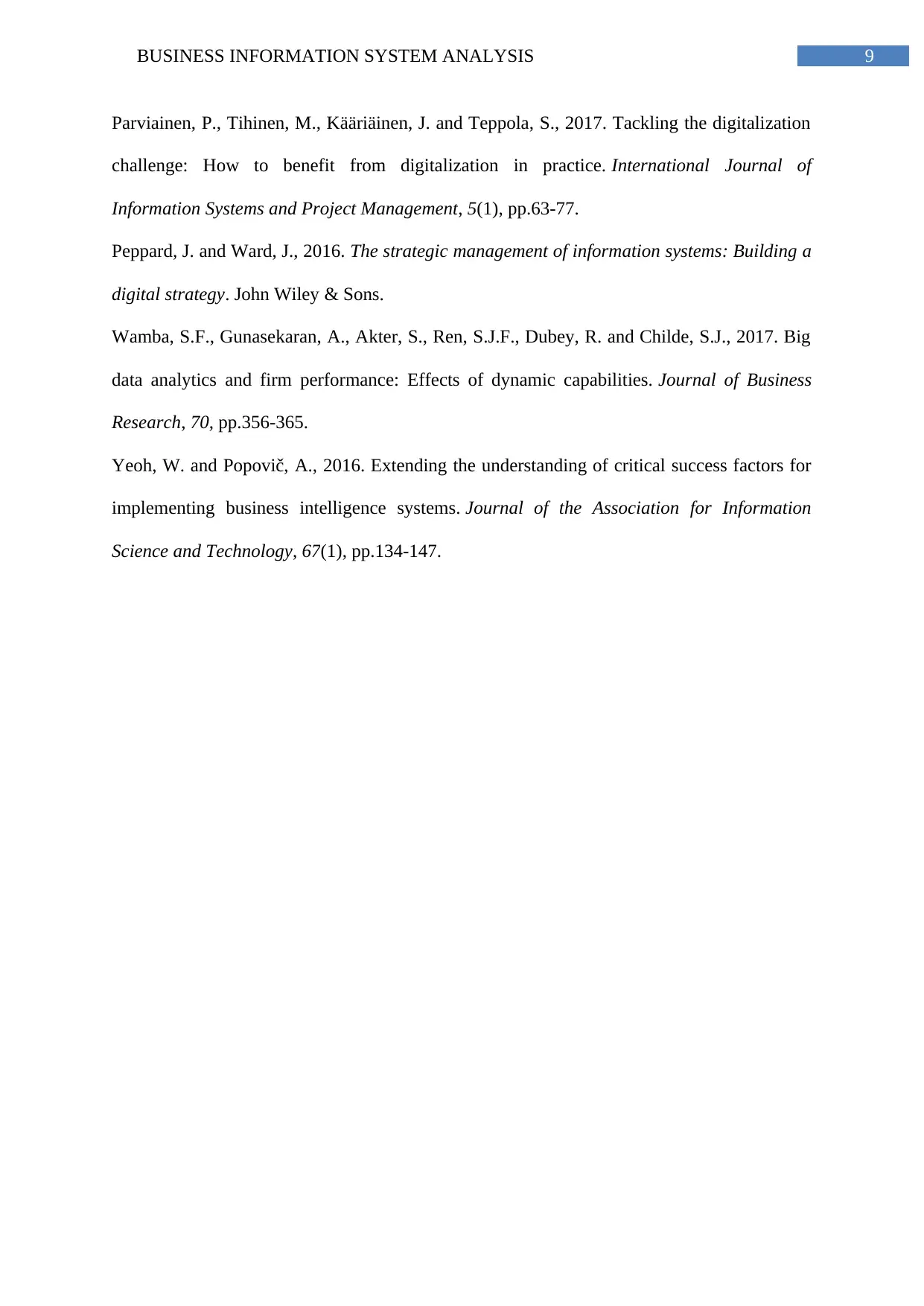
9BUSINESS INFORMATION SYSTEM ANALYSIS
Parviainen, P., Tihinen, M., Kääriäinen, J. and Teppola, S., 2017. Tackling the digitalization
challenge: How to benefit from digitalization in practice. International Journal of
Information Systems and Project Management, 5(1), pp.63-77.
Peppard, J. and Ward, J., 2016. The strategic management of information systems: Building a
digital strategy. John Wiley & Sons.
Wamba, S.F., Gunasekaran, A., Akter, S., Ren, S.J.F., Dubey, R. and Childe, S.J., 2017. Big
data analytics and firm performance: Effects of dynamic capabilities. Journal of Business
Research, 70, pp.356-365.
Yeoh, W. and Popovič, A., 2016. Extending the understanding of critical success factors for
implementing business intelligence systems. Journal of the Association for Information
Science and Technology, 67(1), pp.134-147.
Parviainen, P., Tihinen, M., Kääriäinen, J. and Teppola, S., 2017. Tackling the digitalization
challenge: How to benefit from digitalization in practice. International Journal of
Information Systems and Project Management, 5(1), pp.63-77.
Peppard, J. and Ward, J., 2016. The strategic management of information systems: Building a
digital strategy. John Wiley & Sons.
Wamba, S.F., Gunasekaran, A., Akter, S., Ren, S.J.F., Dubey, R. and Childe, S.J., 2017. Big
data analytics and firm performance: Effects of dynamic capabilities. Journal of Business
Research, 70, pp.356-365.
Yeoh, W. and Popovič, A., 2016. Extending the understanding of critical success factors for
implementing business intelligence systems. Journal of the Association for Information
Science and Technology, 67(1), pp.134-147.
1 out of 10
Related Documents
Your All-in-One AI-Powered Toolkit for Academic Success.
+13062052269
info@desklib.com
Available 24*7 on WhatsApp / Email
![[object Object]](/_next/static/media/star-bottom.7253800d.svg)
Unlock your academic potential
Copyright © 2020–2025 A2Z Services. All Rights Reserved. Developed and managed by ZUCOL.



